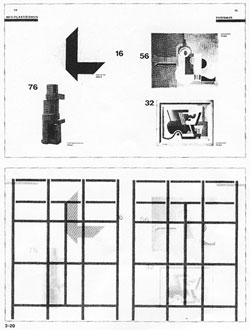 The use of space is a key to how we visually sense, read, and perceive.
It is the frontier of making information visible.
In this grid-style layout by Lissitsky, the use of space focuses our
attention in radical ways.
The use of space is a key to how we visually sense, read, and perceive.
It is the frontier of making information visible.
In this grid-style layout by Lissitsky, the use of space focuses our
attention in radical ways.
reading:
Philip Meggs,
Type and Image,
New York: Van Nostrand Reinhold, 1989.
p 80 - 92
on
electronic reserve.
In this reading you will learn about grid structures.
While sometimes grids are explicit, in almost all other cases of good
visual design, they operate implicitly, lurking beneath the surface.
The examples, as well as the principles, can serve as a basis for your
own ideas.

